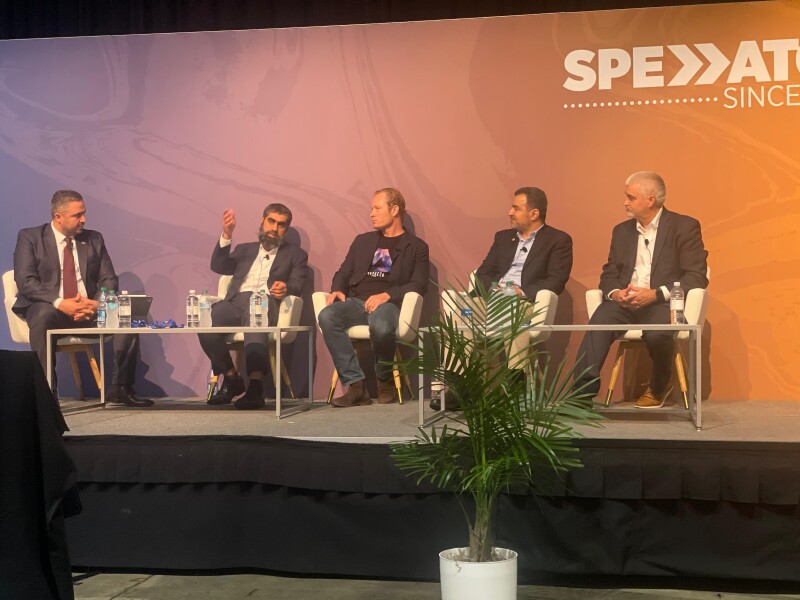Artificial intelligence (AI) may not solve all the oil industry’s problems, but it can certainly contribute to the bottom line.
When developed in line with company goals, AI technology can serve real business cases, but bringing AI solutions into the oil patch requires overcoming certain challenges, speakers said during the “Decoding the Future: Harnessing Digital Petroleum Technologies” session on 24 September at SPE’s Annual Technical Conference and Exhibition in New Orleans.
But just because something has potential doesn’t mean it will be deployed.
Dr. Wael Ziadat, chairman of the SPE Drilling Uncertainty Prediction Technical Section (DUPTS) and ADIPEC 2024 AI and Digital Transformation Committee chairman, as well as Corva’s vice president of Middle East and North Africa, moderated the session. DUPTS organized the panel.
David Johnson, digital solutions principal for Petrolink, said most AI projects don’t scale into the real world.
“95% of all projects around AI never left the lab,” he said. “They worked beautifully in the lab but were not cost effective in the field.”
Development of AI projects should focus on solving specific problems, he added.
Saeed Mubarak, petroleum engineering and intelligent fields consultant for Saudi Aramco, said AI is an enabling technology that is part of the larger toolkit.
“We should not really emphasize AI and forget about real nature” when considering potential applications, he said. Additionally, he said, it’s important to be realistic about AI, particularly as many of the papers presented on the topic only highlight the successes of such projects.
Khaled Al Blooshi, vice president for digital projects and innovation at the Abu Dhabi National Oil Company (ADNOC), said AI has its limitations but noted that digital and AI technologies are still evolving.
“There could be a lot of hype around it in terms of what it can do, but, sooner or later, … the hype cycle will come down, and people will start seeing the real application of this technology, and they will start understanding … the limitations,” he said.
One of the potential applications, he said, is decreasing the time it takes to bring a new engineer up to speed by allowing the recent graduate to tap into the knowledge bank.
“If you think of it, the development time of these young engineers and integrating them is becoming shorter and shorter,” he said.
Where once the minimum training program may have been 3 years, today that integration training program may be “less than 6 months,” he said.
AI in Oil and Gas
Corva CEO Ryan Dawson said a lot of people in technology are “a little bit too optimistic” about what AI can do.
“They’re like, ‘Oh, you know, AI is going to save all of our problems,’ ” he said.
But, for a variety of reasons, it takes time for any technology to deliver results. He pointed at the self-driving car as an example of technology readiness outpacing regulatory processes.
“Even when the technology will come to fruition, we can’t even imagine how long the regulatory process will (take),” he said.
When it comes to AI plans, though, Al Blooshi said it’s important for businesses to set a North Star and then evaluate potential technology through that lens.
“What is the technology capability? What can we do? And then work on trying to achieve that,” he said.
While niche opportunities may drive value, he said, it’s important to be smart about deploying those efforts.
Some years back, ADNOC started its digital transformation and created its Panorama Digital Command Center.
“The idea was, let’s bring all the data from our field operations into a central place and let’s challenge ourselves and see how we can use AI to drive further value,” he said.
In addition to using AI for real-time optimization algorithms, ADNOC trained AI to handle constraint updates for mechanical equipment. ADNOC also implemented an emission-management platform.
“We’ll be implementing a lot of use cases or projects to bring down our emissions. Can we have predictive capabilities or predictive care to see if this is useful? Or do we need to come up with additional measures?” Al Blooshi said.
But where ADNOC has seen the biggest value of harnessing the power of AI, he said, is in supporting decision making. ADNOC has deployed more than 30 applications using AI across upstream and downstream segments.
“In 2023, the business impact of digital and AI was around $500 million, which we were proud of and we have publicly announced,” he said.
ADNOC’s subsurface digital command center is working on automating subsurface workflows.
“Trying to come up with data-driven reservoir models, not yet there, but that’s like the dream, and we’re pushing the boundaries. And I think what we are seeing today is only the tip of the iceberg. The real potential of this technology is huge,” Al Blooshi said.
At the same time, he said it’s important to ensure people are brought along on the digital transformation journey through upskilling.
“It’s not only the technology. You need to come up with a new business model, and you upskill your people and transform your business. It may sound easy, but it is really complex,” he said, noting driving adoption of the technologies is “a science by itself.”
Communication and Automation
Mubarak said additional communication with the field—such as “a field that speaks” via sensors—will help provide better insight into production through something comparable to having a phone conversation with the well.
“I call the well: ‘How are you doing today?’ ‘Well, I’m doing very well, very well. I’m producing at the target rate, but I feel like water cut is coming’ ” because it’s sensing more salinity in the flow, he said. “That’s doable, by the way, with all the technologies that we have.”
Johnson said he expects to see more automation in the oil patch as technology evolves.
“What we can do is work on small, incremental automation improvements that help take people out of harm’s way, and I think that’s the focus we need to be working on in the short term, is simple automation,” he said.
ADNOC’s RoboWell automation project aims to produce wells at optimized rates and lower emissions without damaging the reservoir, Al Blooshi said.
RoboWell implements guidelines “in an automated way where you are always producing at an optimized rate but at the same time not jeopardizing your well guidelines and damaging these wells,” he said.
Challenges
But implementing AI and digital technology comes with challenges. As Al Blooshi noted, it’s not possible to have digital without a transformation.
One of the big challenges, Johnson said, comes around data.
“An operator has more data than they’ve ever had before—all kinds of data. A service provider now has more sensors, higher frequencies of data, more enhancements that are going on to it. So now you have multidimensional problems of your data,” he said.
But to take advantage of machine learning and technologies such as large language models, it’s critical to have confidence in the data, he said.
He cited sensor-activated windshield wipers on cars as an example.
“On the drive over here from Houston, I had a problem. I hit a really big bug, and it splattered all over the sensor, the camera on the car, and my windshield wipers just wouldn’t shut off right. The science was correct. Everything was accurate. It had been implemented correctly. The data was wrong,” Johnson said.
In short, he said, the data must be accurate, accessible, and organized.


